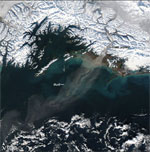Importance of Iron Speciation to Aerosol Solubility: Potential Effects of
Aerosol Source on Ocean Photosynthesis
summary written by Raven Hanna
The world's animals depend on plants, plants depend on photosynthesis, and photosynthesis depends on iron. Despite a relative abundance of this element, iron in a form useable by plants can be rare. Living organisms require soluble iron, which generally comes from environments in flux since iron settles into stable minerals unavailable to life. Since around 30-40% of oceans are iron-limited, understanding the sources of soluble iron is critical to understanding oceanic ecosystems, which are responsible for taking significant amounts of carbon out of the air.
Soluble iron can reach oceans by water currents carrying dusts or by air currents carrying aerosols. For example, glaciers in Alaska can produce iron-rich dust and aerosols as they grind rocks. Carried by air and water, the nutrients find their way to the North Pacific Ocean, supporting its ecosystems. Iron-rich aerosols do not only come from natural sources but are also made by burning fossil fuels. Not all aerosols are created equally; some contain iron that is thousands of times more soluble, and thus more life-supporting, than others. The solubility depends on the chemical form of the iron they carry.
A research team led by Benjamin C. Bostick from Dartmouth College and Andrew Schroth of the United States Geological Survey used SSRL Beam Lines 2-3 and 11-2 to measure the solubility of iron from various aerosol sources, both natural and man-made. Through x-ray absorption spectroscopy, they determined the iron's chemical forms in the samples. The sample with the highest iron solubility came from fossil fuel combustion, and that with the lowest iron solubility came from aerosols originating in the Saharan desert. The aerosols created when glaciers grind rocks beneath them had intermediate solubility.
This research suggests a complex relationship between iron cycles and climate change. While the burning of fossil fuels adds to carbon in the atmosphere, it also adds iron to the oceans that, though aquatic organisms, takes carbon out of the atmosphere. Additionally, receding glaciers caused by climate change will increase the amount and type of rock dust making its way to the oceans, which can also increase biological activity and carbon capture. This work was published in the April 26 issue of the journal Nature Geoscience.
To learn more about this research see the full Scientific Highlight
Andrew W. Schroth, John Crusius, Edward R. Sholkovitz and Benjamin C. Bostick, "Iron solubility driven by speciation in dust sources to the ocean", Nat. Geosci., 2, 337-340 (2009).


